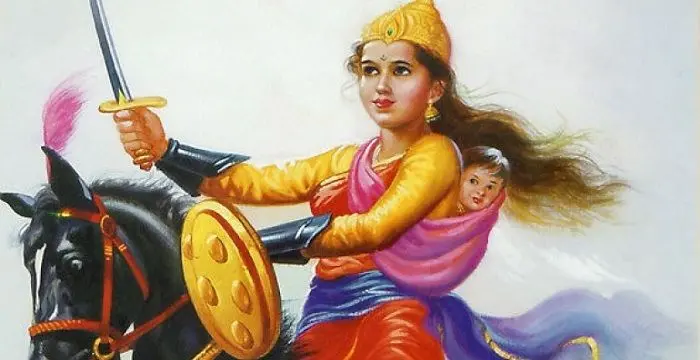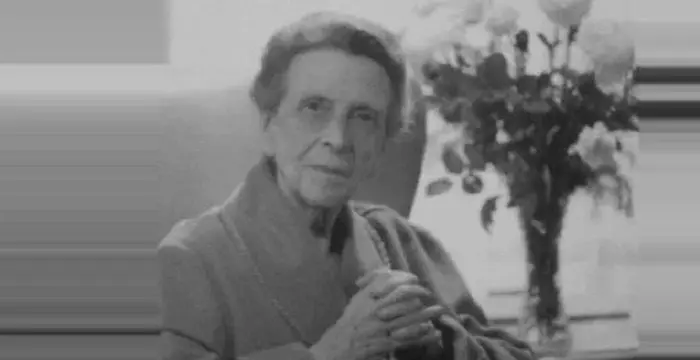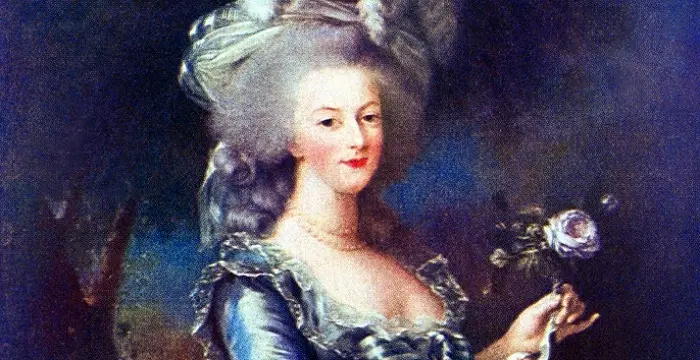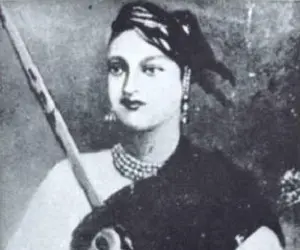
Rani Lakshmibai - Queens, Life Achievements and Family
Rani Lakshmibai's Personal Details
Rani Lakshmibai, famously known as ‘Jhansi Ki Rani’, was one of the leading warriors of India’s First War of Independence
| Information | Detail |
|---|---|
| Birthday | November 19, 1828 |
| Died on | June 18, 1858 |
| Nationality | Indian |
| Famous | Historical Personalities, Empresses & Queens, Revolutionaries, Empresses, Queen of Jhansi State, Queens |
| Nick names | Manu |
| Spouses | Raja Gangadhar Rao Newalkar |
| Known as | Lakshmi Bai, Manikarnika, Manu, Rani of Jhansi |
| Childrens | Anand Rao, Damodar Rao |
| Birth Place | Varanasi |
| Gender | Female |
| Father | Moropant Tambe |
| Mother | Bhagirathi Sapre |
| Sun Sign | Scorpio |
| Born in | Varanasi |
| Famous as | Queen of Jhansi State |
| Died at Age | 29 |
// Famous Queens
Jetsun Pema
Jetsun Pema is the Queen consort of Bhutan. Check out this biography to know about her childhood, family life, achievements and fun facts about her life.
Princess Alice of Battenberg
Princess Andrew of Greece and Denmark, also known as Princess Victoria Alice Elizabeth Julia Marie of Battenberg, was the mother of Prince Philip, Duke of Edinburgh and mother-in-law of Queen Elizabeth II. This biography profiles her childhood, famil
Marie Antoinette
Marie Antoinette was the Queen of France and Navarre from 1774 to 1792. who played a major role in provoking the French Revolution. This biography of Marie Antoinette provides detailed information about her childhood and life
Rani Lakshmibai's photo
Who is Rani Lakshmibai?
Rani Lakshmibai, famously known as ‘Jhansi Ki Rani’, was one of the leading warriors in India’s First War of Independence, which was fought in 1857. Her struggles in life started at the age of four, when her mother passed away. Thereafter she was raised solely by her father along with other soon-to-be revolutionaries and she grew to be an independent, courageous girl. When she was just twenty-four-years old, her husband, the Maharaja of Jhansi died but she didn't lose her courage and took over his responsibilities. When the British company annexed the territories of Jhansi with treachery, she revolted against them with the help of other Indian rebellion leaders. She surprised the British by showing extraordinary fighting spirit and valor in battles fought at Jhansi, then Kalpi and lastly at Gwalior. She inspired many generations of freedom fighters in India, thus becoming immortal in history. The valor and brave death she chose was an inspiration to the patriots such as Shahid Bhagat Singh and to all revolutionaries from Veer Savarkar to Netaji Subhash Chandra Bose. She became a national heroine and is seen as the epitome of female bravery in India.
Childhood & Early Life
She was born on November 19, 1828 in Kashi (present day Varanasi) to Moropanth Tambe, a court adviser, and his wife, Bhagirathi Sapre, an intelligent and religious lady. Her parents belonged to the Maharashtrian Brahmin community.
Her childhood name was Mannikarnika (Manu). She lost her mother at the age of four and the complete responsibility of young Manu fell on her father. She grew up with Nana Sahib and Tatya Tope—the three of them would eventually become active participants in India’s first war of independence.
Besides completing her education, she also received formal training in martial arts. She also learnt horse riding, target shooting and sword fighting.
Accession & Reign
In 1842, she married Raja Gangadhar Rao Newalkar, Maharaja of Jhansi, and was named as ‘Lakshmibai’. In 1851, they were blessed with a child, Damodar Rao, but he died when four months old.
Later, they adopted Anand Rao, the son of Raja Gangadhar Rao’s cousin, and renamed him Damodar Rao. After the death of Raja in November 1853, the British East India Company, under Governor-General Lord Dalhousie, applied the ‘Doctrine of Lapse’. As Damodar Rao was an adopted son, he was declined the throne of Jhansi and the British company annexed the state of Jhansi to its territories through deceit.
In March 1854, she was ordered to leave the Jhansi fort with an annual pension of sixty thousand rupees and move to the Rani Mahal in Jhansi. But she was persistent on protecting the throne of Jhansi for her adopted son.
She was determined not to leave her empire of Jhansi and strengthened its defenses. She assembled a volunteer army where women were also given military training. Her forces were joined by warriors such as Gulam Gaus Khan, Dost Khan, Khuda Baksh, Lala Bhau Bakshi, Moti Bai, Sunder-Mundar, Kashi Bai, Deewan Raghunath Singh and Deewan Jawahar Singh.
On May 10, 1857, while she was assembling an army, the Sepoy (soldier) Mutiny of India, (India’s first war of independence) started in Meerut. During this rebellion many British civilians, including women and children were killed by the Indian soldiers. Meanwhile, the British troops were forced to focus their attention on ending the rebellion quickly and thus, she was left to rule her kingdom on behalf of the company.
In June 1857, few rebels of the 12th Bengal Native Infantry seized the Jhansi fort containing the treasure and murdered the European officers of the battalion along with their wives and children. Due to this, she assumed the administration of the city and wrote a letter to British superintendent explaining the events which led her to do so.
Under her reign, there occurred an invasion of Jhansi by the forces of British Company allies ‘Orchha’ and ‘Datia’; their intention was to divide Jhansi among themselves. She appealed to the British for help but received no response from them. Therefore, she assembled forces and defeated the invaders in August 1857.
During the period of August 1857-January 1858, Jhansi under her rule was at peace. But the non-arrival of British forces strengthened her party and encouraged Indian troops to fight for independence from British rule. When the company forces arrived and demanded her to surrender the city, she refused to hand it over and defended her kingdom. Thus, began the battle of Jhansi on March 23, 1858.
She, along with her troops, fought courageously for the kingdom of Jhansi but the British forces overpowered her army and she was forced to flee with her son to Kalpi, where she was joined by additional rebel forces, including Tatya Tope.
On May 22, 1858, the British forces attacked Kalpi and defeated the Indian troops again which forced the leaders, including Lakshmibai, to flee to Gwalior. The rebel army was able to occupy the Gwalior city without any opposition. A British attack on Gwalior was imminent but she was unable to persuade other leaders to prepare for it. On June 16, 1858, the British forces attacked the city where she was killed in a fierce battle.
Personal Life & Legacy
On June 18, 1858, she died in Gwalior in the battle, at the hands of the British army. She fought with undying patriotism till her last breath and achieved martyrdom upon her death.
// Famous Empresses
Jetsun Pema
Jetsun Pema is the Queen consort of Bhutan. Check out this biography to know about her childhood, family life, achievements and fun facts about her life.
Princess Alice of Battenberg
Princess Andrew of Greece and Denmark, also known as Princess Victoria Alice Elizabeth Julia Marie of Battenberg, was the mother of Prince Philip, Duke of Edinburgh and mother-in-law of Queen Elizabeth II. This biography profiles her childhood, famil
Marie Antoinette
Marie Antoinette was the Queen of France and Navarre from 1774 to 1792. who played a major role in provoking the French Revolution. This biography of Marie Antoinette provides detailed information about her childhood and life
Rani Lakshmibai biography timelines
- // 19th Nov 1828She was born on November 19, 1828 in Kashi (present day Varanasi) to Moropanth Tambe, a court adviser, and his wife, Bhagirathi Sapre, an intelligent and religious lady. Her parents belonged to the Maharashtrian Brahmin community.
- // 1842In 1842, she married Raja Gangadhar Rao Newalkar, Maharaja of Jhansi, and was named as ‘Lakshmibai’. In 1851, they were blessed with a child, Damodar Rao, but he died when four months old.
- // Nov 1853Later, they adopted Anand Rao, the son of Raja Gangadhar Rao’s cousin, and renamed him Damodar Rao. After the death of Raja in November 1853, the British East India Company, under Governor-General Lord Dalhousie, applied the ‘Doctrine of Lapse’. As Damodar Rao was an adopted son, he was declined the throne of Jhansi and the British company annexed the state of Jhansi to its territories through deceit.
- // Mar 1854In March 1854, she was ordered to leave the Jhansi fort with an annual pension of sixty thousand rupees and move to the Rani Mahal in Jhansi. But she was persistent on protecting the throne of Jhansi for her adopted son.
- // 10th May 1857On May 10, 1857, while she was assembling an army, the Sepoy (soldier) Mutiny of India, (India’s first war of independence) started in Meerut. During this rebellion many British civilians, including women and children were killed by the Indian soldiers. Meanwhile, the British troops were forced to focus their attention on ending the rebellion quickly and thus, she was left to rule her kingdom on behalf of the company.
- // Jun 1857In June 1857, few rebels of the 12th Bengal Native Infantry seized the Jhansi fort containing the treasure and murdered the European officers of the battalion along with their wives and children. Due to this, she assumed the administration of the city and wrote a letter to British superintendent explaining the events which led her to do so.
- // Aug 1857Under her reign, there occurred an invasion of Jhansi by the forces of British Company allies ‘Orchha’ and ‘Datia’; their intention was to divide Jhansi among themselves. She appealed to the British for help but received no response from them. Therefore, she assembled forces and defeated the invaders in August 1857.
- // Aug 1857 To Jan 1858During the period of August 1857-January 1858, Jhansi under her rule was at peace. But the non-arrival of British forces strengthened her party and encouraged Indian troops to fight for independence from British rule. When the company forces arrived and demanded her to surrender the city, she refused to hand it over and defended her kingdom. Thus, began the battle of Jhansi on March 23, 1858.
- // 16th Jun 1858On May 22, 1858, the British forces attacked Kalpi and defeated the Indian troops again which forced the leaders, including Lakshmibai, to flee to Gwalior. The rebel army was able to occupy the Gwalior city without any opposition. A British attack on Gwalior was imminent but she was unable to persuade other leaders to prepare for it. On June 16, 1858, the British forces attacked the city where she was killed in a fierce battle.
- // 18th Jun 1858On June 18, 1858, she died in Gwalior in the battle, at the hands of the British army. She fought with undying patriotism till her last breath and achieved martyrdom upon her death.
// Famous Historical Personalities
Sundiata Keita
Sundiata Keita was the founder of the Mali Empire in West Africa. This biography profiles his childhood, early life, struggles, founding of empire, rule, administration, achievements and also gives some fun facts.
Ashoka
Ashoka was the third emperor of the Mauryan Dynasty and ruled almost the entire Indian subcontinent. This biography profiles his childhood, life, reign, achievements and timeline
Jetsun Pema
Jetsun Pema is the Queen consort of Bhutan. Check out this biography to know about her childhood, family life, achievements and fun facts about her life.
Murad IV
Murad IV was one of the mighty Sultans in the history of the Ottoman Empire. This biography profiles his childhood, family, accession, rule, administration and timeline.
Xerxes I
Xerxes I (Xerxes the Great) was the fourth and the most famous king of the Archaemenid dynasty of Persia. This biography profiles his childhood, family, personal life, life history, achievements, campaigns, administration, death and other facts.
Sargon of Akkad
Sargon of Akkad, also called ‘Sargon the Great’, ‘Sarru-Kan’ and ‘Shar-Gani-Sharri’, was the founder and first king of the Akkadian Empire. This biography profiles his childhood, life, rule, administration, timeline, and gives some fun facts.
Rani Lakshmibai's FAQ
What is Rani Lakshmibai birthday?
Rani Lakshmibai was born at 1828-11-19
When was Rani Lakshmibai died?
Rani Lakshmibai was died at 1858-06-18
Where was Rani Lakshmibai died?
Rani Lakshmibai was died in Gwalior
Which age was Rani Lakshmibai died?
Rani Lakshmibai was died at age 29
Where is Rani Lakshmibai's birth place?
Rani Lakshmibai was born in Varanasi
What is Rani Lakshmibai nationalities?
Rani Lakshmibai's nationalities is Indian
What is Rani Lakshmibai nick names?
Rani Lakshmibai's nickNames is Manu
Who is Rani Lakshmibai spouses?
Rani Lakshmibai's spouses is Raja Gangadhar Rao Newalkar
Who is Rani Lakshmibai childrens?
Rani Lakshmibai's childrens is Anand Rao, Damodar Rao
Who is Rani Lakshmibai's father?
Rani Lakshmibai's father is Moropant Tambe
Who is Rani Lakshmibai's mother?
Rani Lakshmibai's mother is Bhagirathi Sapre
What is Rani Lakshmibai's sun sign?
Rani Lakshmibai is Scorpio
How famous is Rani Lakshmibai?
Rani Lakshmibai is famouse as Queen of Jhansi State








